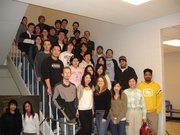07-401/G&M Article: Difference between revisions
From Drorbn
Jump to navigationJump to search
No edit summary |
No edit summary |
||
| (3 intermediate revisions by 2 users not shown) | |||
| Line 1: | Line 1: | ||
{{07-401/Navigation}} |
|||
I found this today on the Globe and Mail newspaper website. |
|||
Thought it might interest some of you. |
|||
I found [http://www.theglobeandmail.com/servlet/story/RTGAM.20070320.wmathpuz0320/BNStory/Science/home this] today on the Globe and Mail newspaper website and thought it might interest some of you. |
|||
----------------------------------- |
|||
'''120-year-old math puzzle solved''' |
|||
Associated Press |
|||
PALO ALTO, Calif. — An international team of mathematicians has cracked a 120-year-old puzzle that researchers say is so complicated its handwritten solution would cover the island of Manhattan. |
|||
The 18-member group of mathematicians and computer scientists was convened by the American Institute of Mathematics in Palo Alto to map a theoretical object known as the “Lie group E8.” |
|||
Lie (pronounced Lee) groups were invented by 19th-century Norwegian mathematician Sophus Lie in his study of symmetrical objects, especially spheres, and differential calculus. |
|||
The E8 group, which dates to 1887, is the most complicated Lie group, with 248 dimensions, and was long considered impossible to solve. |
|||
“To say what precisely it is is something even many mathematicians can't understand,” said Jeffrey Adams, the project's leader and a math professor at the University of Maryland. |
|||
The problem's proof, announced at the Massachusetts Institute of Technology, took the researchers four years to find. It involves about 60 times as much data as the Human Genome Project. |
|||
When stored in highly compressed form on a computer hard drive, the solution takes up as much space as 45 days of continuous music in MP3 format. |
|||
“It's like a Mount Everest of mathematical structures they've climbed now,” said Brian Conrey, director of the institute. |
|||
The calculation does not have any obvious practical applications but could help advance theoretical physics and geometry, researchers said. |
|||
Latest revision as of 15:04, 8 July 2007
| |||||||||||||||||||||||||||||||||||||||||||||||||||||||||
I found this today on the Globe and Mail newspaper website and thought it might interest some of you.
